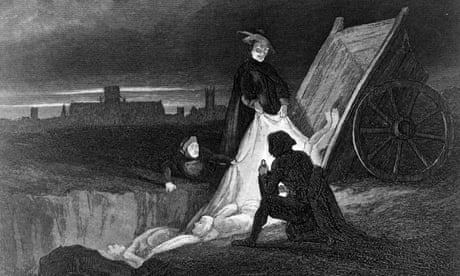Inner-city poor suffered most while rich decamped to countryside – but numbers started falling as winter cold killed off rats
Paul Brown
Mon 9 Nov 2020

An engraving showing a street scene in London during the great plague in the 1660s. Photograph: Universal History Archive/UIG via Getty Images
The king, Charles II, imposed a lockdown to prevent people mixing, ships with infection aboard were quarantined, food deliveries were organised for the poor, trade was suspended, fairs banned and the Scottish border closed. This is 1665 as attempts were made to halt the great plague. London lost 15% of its population. Officially the capital’s death toll was 68,596 but it was probably nearer to 100,000. Other big cities suffered too, especially York.

Mapping London's great plague of 1665
The king and his courtiers decamped to the safety of Oxford. Lawyers, rich merchants and doctors fled to the countryside. What sounds horribly familiar is that it was the poor and deprived, living in cramped conditions in the inner-city suburbs, that suffered most. The servants, shoemakers and tradesmen lost their jobs. A contact with an infectious person meant 40 days in quarantine at home. A red cross was painted on the door and watchmen were employed to make sure order was enforced. At night, carts passed through the streets with cries of “bring out your dead”.
The difference is that on this day, 10 November, the number of deaths began to fall dramatically, having peaked at 7,000 a day in September. The winter cold was killing off the rats and their fleas that spread the bubonic plague. Life began to return to normal by Christmas.
The king, Charles II, imposed a lockdown to prevent people mixing, ships with infection aboard were quarantined, food deliveries were organised for the poor, trade was suspended, fairs banned and the Scottish border closed. This is 1665 as attempts were made to halt the great plague. London lost 15% of its population. Officially the capital’s death toll was 68,596 but it was probably nearer to 100,000. Other big cities suffered too, especially York.

Mapping London's great plague of 1665
The king and his courtiers decamped to the safety of Oxford. Lawyers, rich merchants and doctors fled to the countryside. What sounds horribly familiar is that it was the poor and deprived, living in cramped conditions in the inner-city suburbs, that suffered most. The servants, shoemakers and tradesmen lost their jobs. A contact with an infectious person meant 40 days in quarantine at home. A red cross was painted on the door and watchmen were employed to make sure order was enforced. At night, carts passed through the streets with cries of “bring out your dead”.
The difference is that on this day, 10 November, the number of deaths began to fall dramatically, having peaked at 7,000 a day in September. The winter cold was killing off the rats and their fleas that spread the bubonic plague. Life began to return to normal by Christmas.
No comments:
Post a Comment